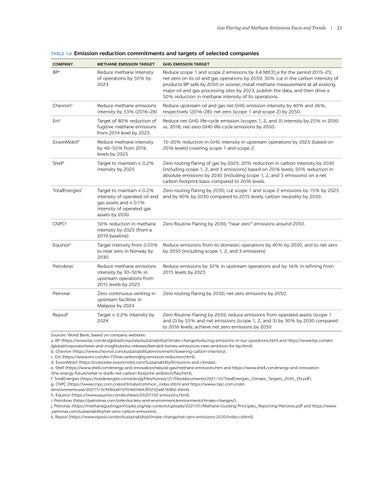Gas Flaring and Methane Emissions Facts and Trends
TABLE 1.8
|
23
Emission reduction commitments and targets of selected companies
COMPANY
METHANE EMISSION TARGET
GHG EMISSION TARGET
BPa
Reduce methane intensity of operations by 50% by 2023
Reduce scope 1 and scope 2 emissions by 3.4 MtCO2e for the period 2015–25; net zero on its oil and gas operations by 2050; 50% cut in the carbon intensity of products BP sells by 2050 or sooner; install methane measurement at all existing major oil and gas processing sites by 2023, publish the data, and then drive a 50% reduction in methane intensity of its operations.
Chevronb
Reduce methane emissions intensity by 53% (2016–28)
Reduce upstream oil and gas net GHG emission intensity by 40% and 26%, respectively (2016–28); net zero (scope 1 and scope 2) by 2050.
Enic
Target of 80% reduction of fugitive methane emissions from 2014 level by 2025
Reduce net GHG life-cycle emission (scopes 1, 2, and 3) intensity by 25% in 2030 vs. 2018; net-zero GHG life-cycle emissions by 2050.
ExxonMobild
Reduce methane intensity by 40–50% from 2016 levels by 2025
15–20% reduction in GHG intensity in upstream operations by 2025 (based on 2016 levels) covering scope 1 and scope 2.
Shelle
Target to maintain < 0.2% intensity by 2025
Zero routing flaring of gas by 2025; 20% reduction in carbon intensity by 2030 (including scope 1, 2, and 3 emissions) based on 2016 levels; 50% reduction in absolute emissions by 2030 (including scope 1, 2, and 3 emissions) on a net carbon footprint basis compared to 2016 levels.
TotalEnergiesf
Target to maintain < 0.2% Zero routing flaring by 2030; cut scope 1 and scope 2 emissions by 15% by 2025 intensity of operated oil and and by 40% by 2030 compared to 2015 levels; carbon neutrality by 2050. gas assets and < 0.1% intensity of operated gas assets by 2030
CNPCg
50% reduction in methane intensity by 2025 (from a 2019 baseline)
Zero Routine Flaring by 2030; “near zero” emissions around 2050.
Equinorh
Target intensity from 0.03% to near zero in Norway by 2030
Reduce emissions from its domestic operations by 40% by 2030, and to net zero by 2050 (including scope 1, 2, and 3 emissions)
Petrobrasi
Reduce methane emissions intensity by 30–50% in upstream operations from 2015 levels by 2025
Reduce emissions by 32% in upstream operations and by 16% in refining from 2015 levels by 2025
Petronaj
Zero continuous venting in upstream facilities in Malaysia by 2024
Zero routing flaring by 2030; net zero emissions by 2050.
Repsolk
Target < 0.2% intensity by 2024
Zero Routine Flaring by 2030; reduce emissions from operated assets (scope 1 and 2) by 55% and net emissions (scope 1, 2, and 3) by 30% by 2030 compared to 2016 levels; achieve net zero emissions by 2050
Sources: World Bank, based on company websites: a. BP (https://www.bp.com/en/global/corporate/sustainability/climate-change/reducing-emissions-in-our-operations.html and https://www.bp.com/en /global/corporate/news-and-insights/press-releases/bernard-looney-announces-new-ambition-for-bp.html). b. Chevron (https://www.chevron.com/sustainability/environment/lowering-carbon-intensity). c. Eni (https://www.eni.com/en-IT/low-carbon/ghg-emission-reduction.html). d. ExxonMobil (https://corporate.exxonmobil.com/Sustainability/Emissions-and-climate). e. Shell (https://www.shell.com/energy-and-innovation/natural-gas/methane-emissions.htm and https://www.shell.com/energy-and-innovation /the-energy-future/what-is-shells-net-carbon-footprint-ambition/faq.html). f. TotalEnergies (https://totalenergies.com/sites/g/files/nytnzq121/files/documents/2021-10/TotalEnergies_Climate_Targets_2030_EN.pdf). g. CNPC (https://www.cnpc.com.cn/en/climate/common_index.shtml and https://www.cnpc.com.cn/en /environmentcase/202111/3c9060a87d704600b63f0232a6f16962.shtml). h. Equinor (https://www.equinor.com/en/news/20201102-emissions.html). i. Petrobras (https://petrobras.com.br/en/society-and-environment/environment/climate-changes/). j. Petronas (https://methaneguidingprinciples.org/wp-content/uploads/2021/01/Methane-Guiding-Principles_Reporting-Petronas.pdf and https://www .petronas.com/sustainability/net-zero-carbon-emissions). k. Repsol (https://www.repsol.com/en/sustainability/climate-change/net-zero-emissions-2050/index.cshtml).


